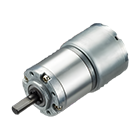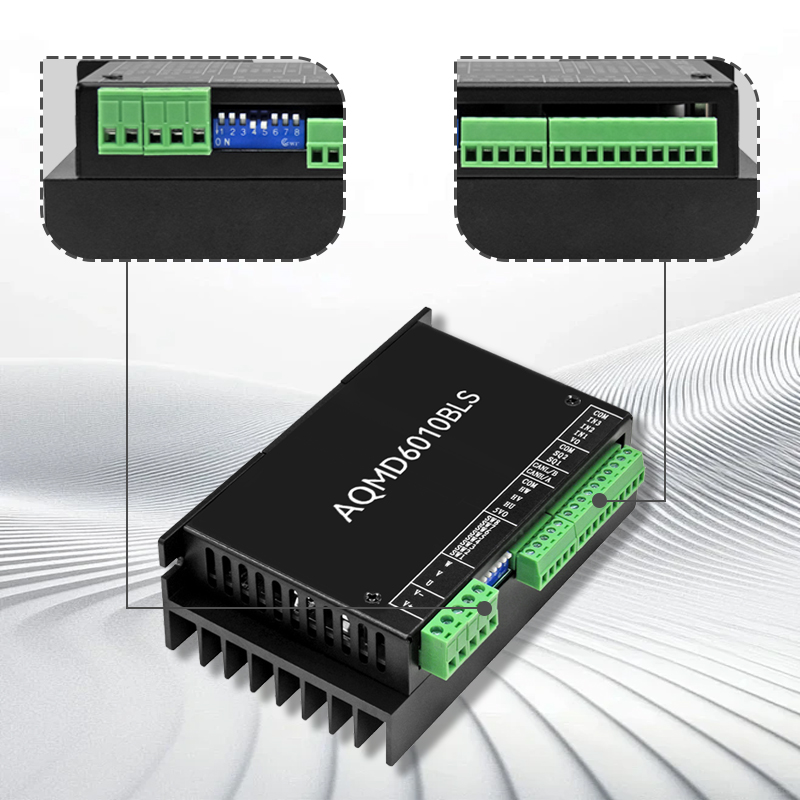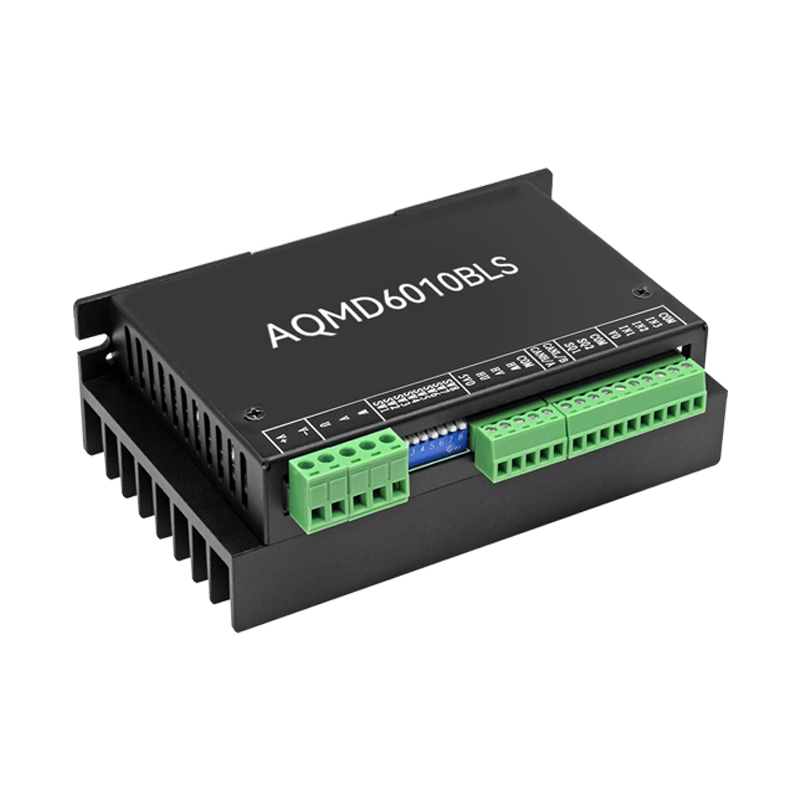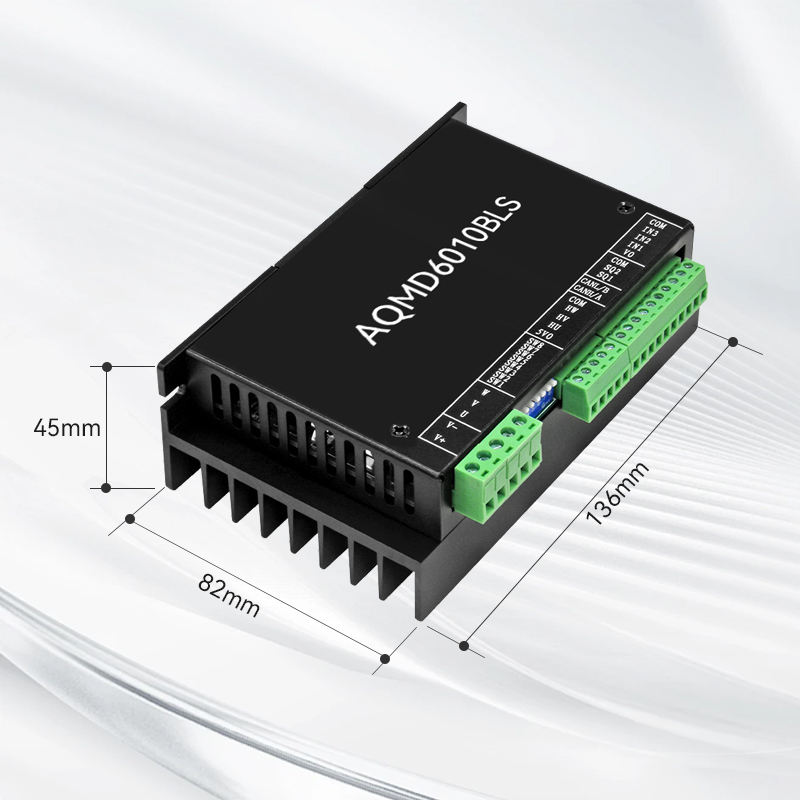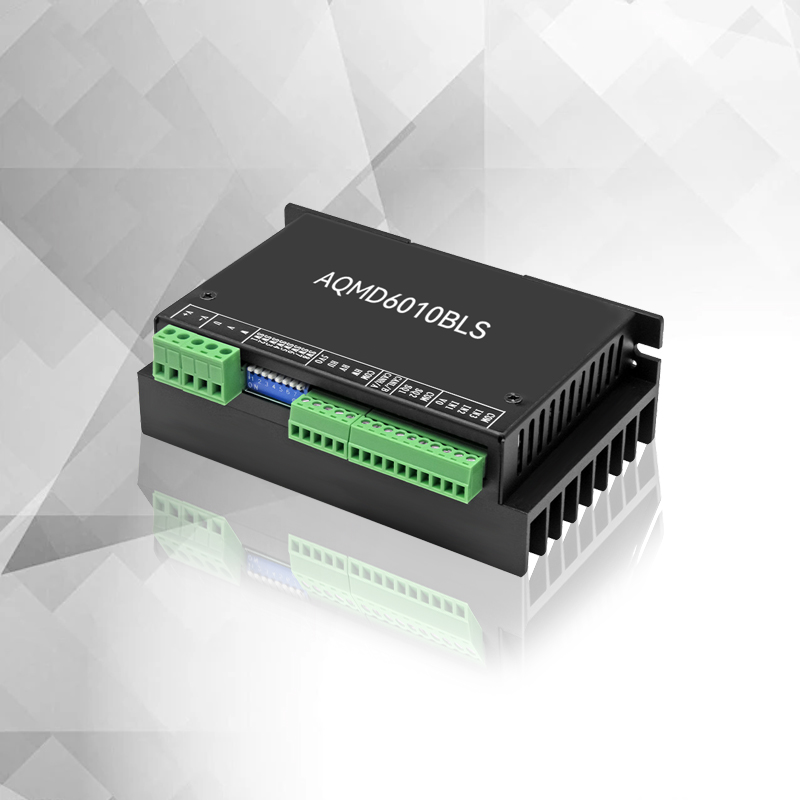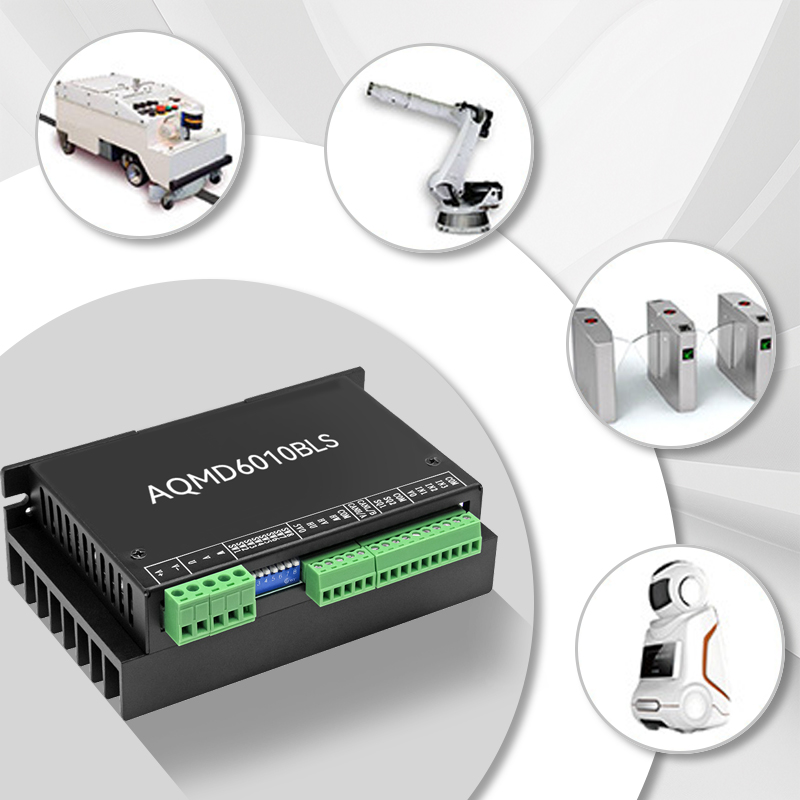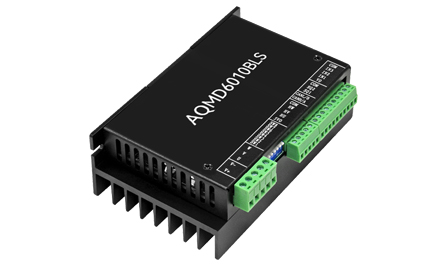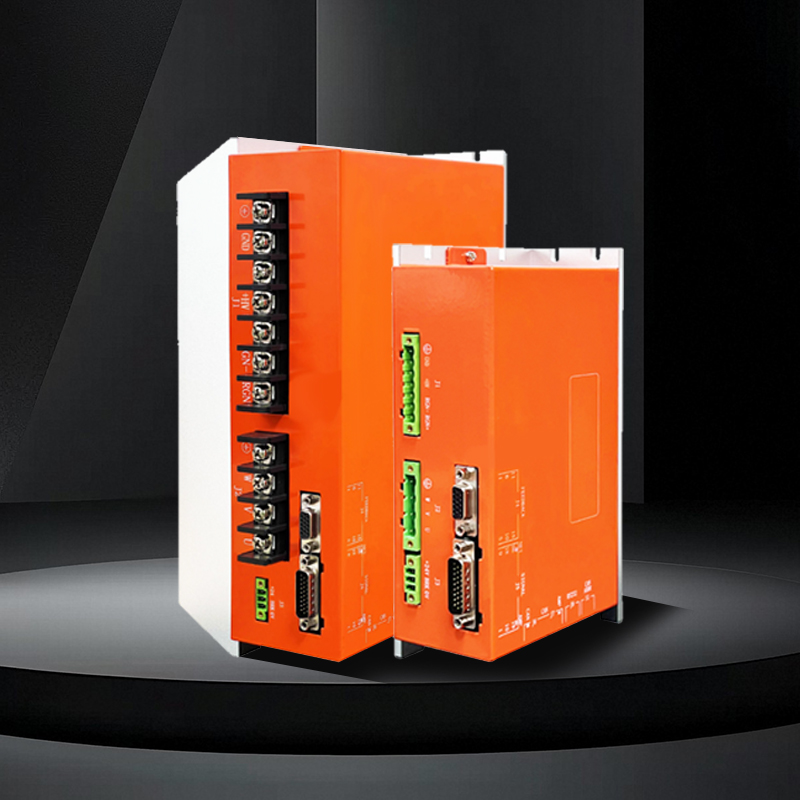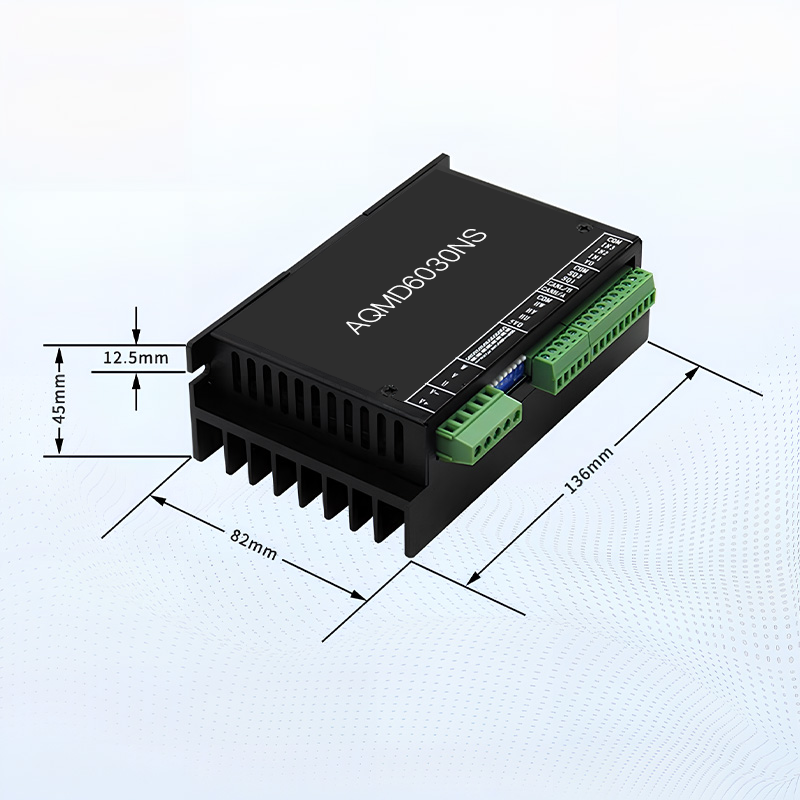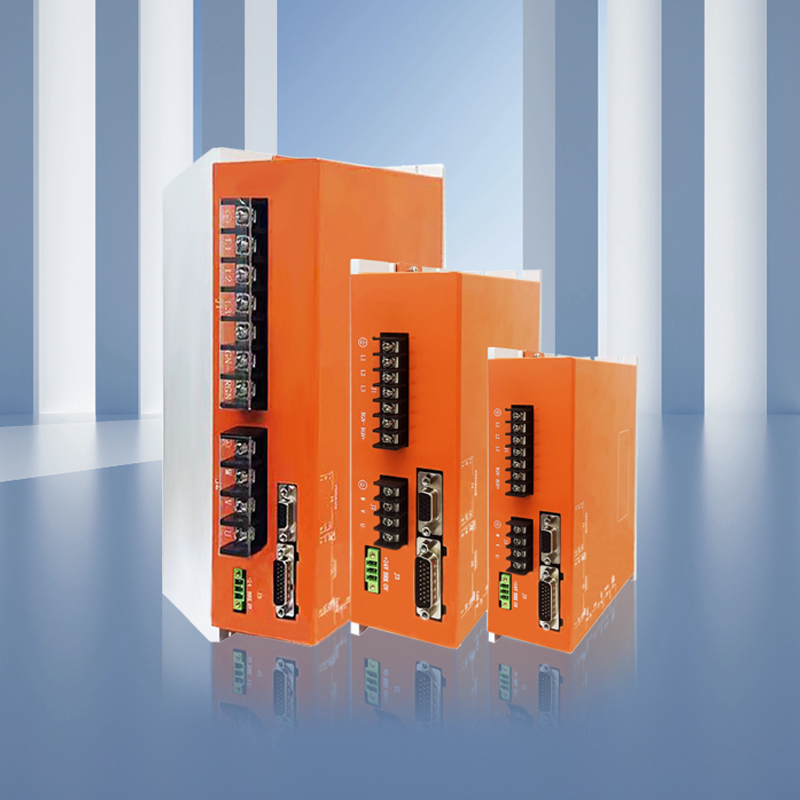Product Description
Model: AQMD6010BLS-E2 |
|
The AQMD_BLS series motor driver adopts advanced precise motor current detection technology, self-speed measurement of inductive brushless motors, detection of the rotation position of inductive brushless motors, regenerative current constant current braking and acceleration control technology, and PID regulation technology to perfectly control the smooth forward and reverse rotation, reversing and braking of the motor. The output current is regulated in real time to prevent overcurrent. Precisely control the motor speed and rotation position, resulting in a short motor response time and low recoil force. | |
Functional characteristics
◆ Voltage range: 9-60V, rated current: 10A, maximum current: 20A;
◆ Potentiometer, 0~3.3/5/10V analog signal, 0/3.3/5/24V logic level, switch quantity, PWM, frequency, pulse, RS485/CAN multiple input signals;
◆ Multiple speed regulation modes such as duty cycle speed regulation, torque control (constant current), speed closed-loop control (constant speed), and position closed-loop control (Angle/distance control);
◆ Support the control of acceleration and deceleration buffer time and acceleration during acceleration and deceleration. It can automatically accelerate and decelerate within the specified stroke and precisely position.
◆ PID regulation of motor current. The maximum starting/load current and braking (braking) current can be configured separately. The motor is overloaded/blocked and stops due to current limiting.
◆ Support internal temperature detection of the driver and configurable overheat protection temperature;
◆ Supports double current output, and can output a large torque during startup and heavy load.
◆Support the monitoring of the power supply voltage of the driver, and the overvoltage/undervoltage shutdown detection values can be configured;
◆Support motor speed measurement and motor locked-rotor detection; Supports external limit switch limit and locked-rotor limit.
◆Support motor phase sequence learning; Support Hall error protection and fault alarm;
◆ 485/CAN communication isolation, supporting multi-site communication, convenient for control by various controllers (such as single-chip microcomputer, PC or PLC), and supporting communication interruption and stoppage protection;
◆ Extremely small PWM dead time, only 0.5 μ s, with an effective PWM range of 0.1% to 100%;
◆ With a PWM frequency of 18kHz/20kHz, there is no PWM noise during motor speed regulation.
◆ Use the ARM Cortex-M3/M4 processor.
Principle Overview
This driver employs advanced motor current precise detection technology, self-speed measurement for inductive brushless motors, detection of the rotation position of inductive brushless motors, regenerative current constant current braking (or braking) technology, and powerful PID regulation technology to perfectly control the smooth forward and reverse rotation, reversing, and braking of the motor. The output current is regulated in real time to prevent overcurrent, precisely controlling the motor speed and rotation position. The motor has a short response time and a small recoil force.
The front of the driver
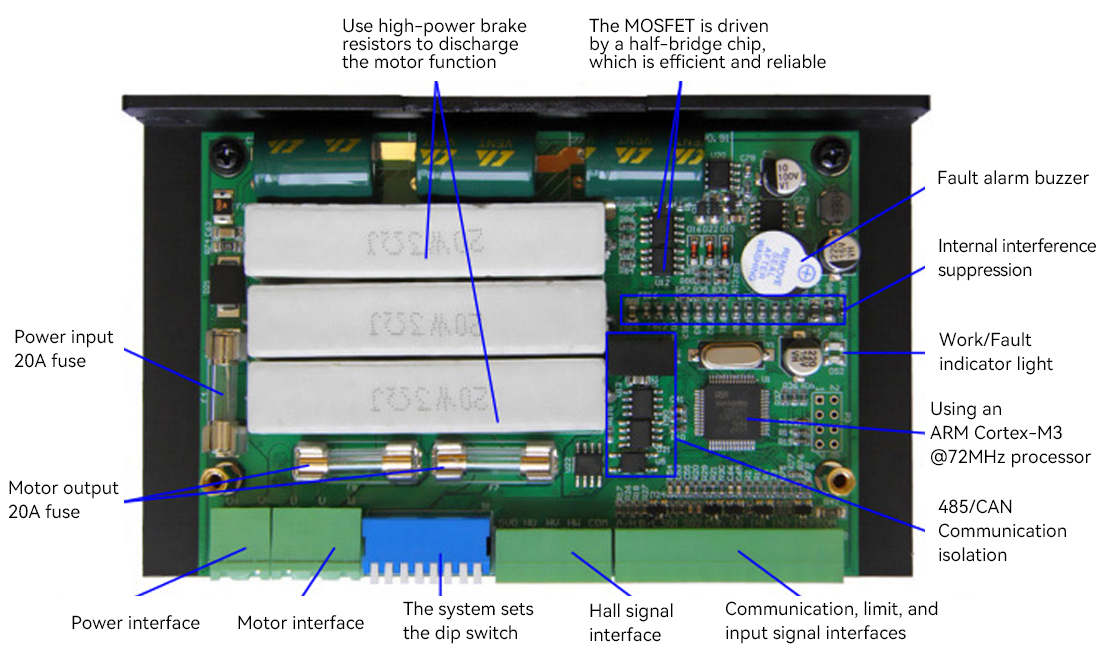
Back of the driver

Application
Application scope: AGV intelligent carts, mechanical arms, passage gates, food delivery
elevators, service robots, warehouse robots, platform doors, various types of automatic control, etc
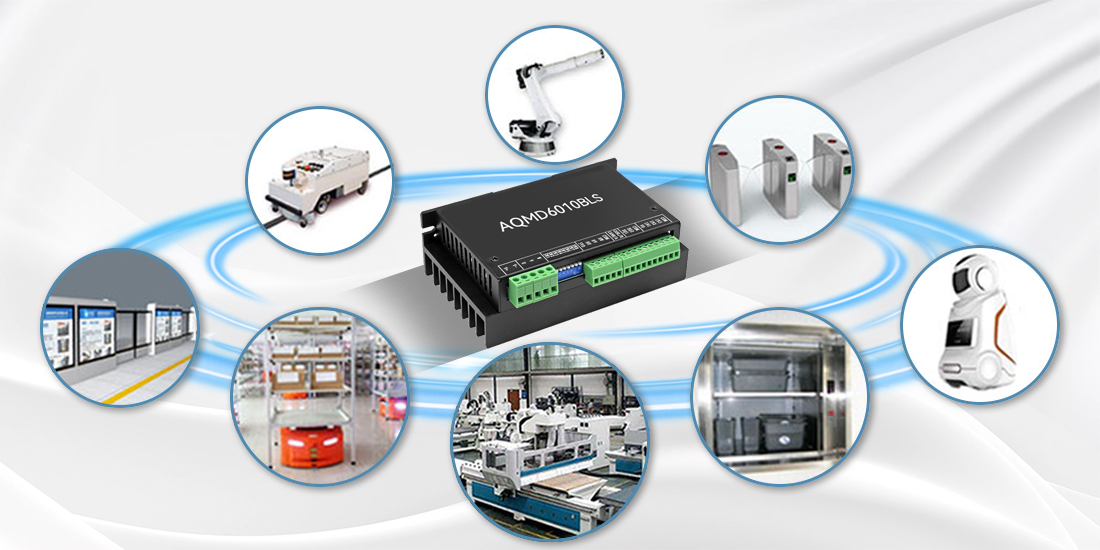
Product parameters
Parameter comparison of AQMD6010BLS series drivers | |||||
Project | Standard Model (Recommended) | Overheat protection basic model | 485 Isolation Economic model | 485 Isolation Enhanced Version | Ordinary style |
(AQMD6010BLS-E2) | (AQMD6010BLS-B2) | (AQMD6010BLS-A2) | (AQMD6010BLS-A1) | (AQMD6010BLS) | |
Control signal type | Potentiometer, analog quantity, PWM, frequency, pulse, level, switch quantity, communication control | ||||
Motor control mode | Duty cycle (open-loop) speed regulation, speed closed-loop, position closed-loop, and torque limit control | ||||
Position control braking mode | Constant acceleration braking ensures more precise, stable and rapid positioning | Brake resistor energy consumption braking | |||
Power supply voltage range | 9~60V | ||||
Rated current | 10A | ||||
Maximum output current | 20A | 12A | |||
Double current output | Support | Support | Support | Support | Not supported |
Overload current limiting | Support | Support | Support | Support | Support |
Blocked rotor shutdown | Support | Support | Support | Support | Support |
Abnormal large current shutdown | Support | Support | Support | Support | Not supported |
Short-circuit protection | Support | Full-speed support | Full-speed support | Full-speed support | Not supported |
Internal temperature measurement | Support | Support | Support | Support | Support |
Overheat current limiting/shutdown | |||||
Power supply voltage measurement | Support | Support | Support | Support | Support |
Overvoltage/undervoltage shutdown | |||||
Communication interface protection | 485/CAN isolation, ESD | 485 common mode voltage protection, ESD | 485 isolation, ESD | 485 isolation, ESD | ESD |
Materials used | High-quality domestic original | The main ics are high-quality imported original products, while the rest of the components are high-quality domestic original products | |||
Suitable motor parameters: | |||||
Technical parameters
Project | Parameters |
Power input voltage | DC 9V~60V |
Rated output current | 10A |
Maximum output current | 12A(non-double current)/20A(double current) |
Maximum soft braking current | 6A |
Support the motor speed range | 0 to 100,000 RPM |
Number of output channels | Single path |
Potentiometer resistance value | 10K to 50K |
The voltage range accepted by the input signal interface | 0V to 25V(except for the fault/completion signal output port) |
Single-ended analog signal input voltage range | Any within the range of 0 to 10V |
Differential analog signal input voltage range | Any within the range of -3.3V to +3.3V |
Logic level voltage range | Any level within the range of 0 to 24V, including LvTTL,TTL,HvTTL,PLC, etc |
RS485/CAN communication parameter range | The 485 baud rate is 1200 to 115200 BPS, and the CAN baud rate is 10k to 1Mbps |
Support for Modbus | Supports Modbus-RTU, supports 03H, 06H, and 10H function codes, configurable slave station address range 1 to 127, and supports broadcasting |
Current detection resolution | 0.02 A |
Constant flow control accuracy | 0.04 A |
Duty cycle speed regulation range | -100.0% to 0,0 to 100.0% |
Stable speed control adjustment range | -3276.8Hz to 3276.7Hz |
Position control adjustment range | -2147483648 ~ 2147483647 |
Torque control adjustment range | 0.5A to 12A |
The setting range of instantaneous overcurrent turn-off current | 0 to 48A |
The range of the current multiplier can be set | 1.00-2.00 |
The multiplier time can be set within a certain range | 0.1 S to 99.9 S |
Temperature measurement range | - 40 ℃ ~ 125 ℃ |
Effective detection range of voltage | 8 to 70V |
Limit control | Support; Two external limit switches can be connected for limit or locked rotor time limit |
Soft start/soft braking | Support; Current-limited start, braking, and setting of acceleration and deceleration time as well as acceleration are available |
Overcurrent/locked rotor protection | Support; Overcurrent time-limited current output The machine can be shut down when the rotor is blocked |
Reverse power connection protection | Built-in 20A fast-melt fuse reverse connection protection |
Output short-circuit protection | Support; Instantaneous high current detection and built-in 20A fast-melt fuse protection |
Braking action time | Soft braking usually takes 0.1 seconds to 0.3 seconds |
Working temperature | -30℃~70℃ |
External dimensions | 136mm×82mm×45mm |
Configuration of dip switches | ||||
1.Control mode configuration | ||||
SW1-SW7 | SW8 | Control mode | ||
Arbitrary | OFF | Digital/analog signal control mode | ||
Slave station address | ON | 485 communication control mode | ||
2.Motor rated current configuration | ||||
SW5-SW7 | SW8 | Rated current | ||
OFF OFF OFF | OFF | The rated current is configured with 485, and the default is 8.4A | ||
ON OFF OFF | OFF | 1A | ||
OFF ON OFF | OFF | 2A | ||
ON ON OFF | OFF | 3A | ||
OFF OFF ON | OFF | 5A | ||
ON OFF ON | OFF | 6A | ||
OFF ON ON | OFF | 8A | ||
ON ON ON | OFF | 10A | ||
3.Signal source selection | ||||
SW4 | SW5 | SW8 | Signal source | |
OFF | OFF | OFF | Potentiometer | |
ON | OFF | OFF | Analog signal | |
OFF | ON | OFF | PWM/ Pulse/frequency | |
ON | ON | OFF | Built-in program | |
4.Working mode configuration | ||||
SW4-SW5 | SW6-SW7 | SW8 | Speed regulation mode | |
It is not ON at the same time | OFF OFF | OFF | Duty cycle speed regulation | |
ON OFF | OFF | Torque control | ||
OFF ON | OFF | Speed closed-loop control | ||
ON ON | OFF | Position closed-loop control | ||
At the same time, be ON | OFF OFF | OFF | Motor learning | |
ON OFF | OFF | Itinerary learning | ||
OFF ON | OFF | Preset speed control | ||
ON ON | OFF | Retain | ||
Typical usage
1.The connection method of single potentiometer duty cycle/closed-loop speed regulation point control
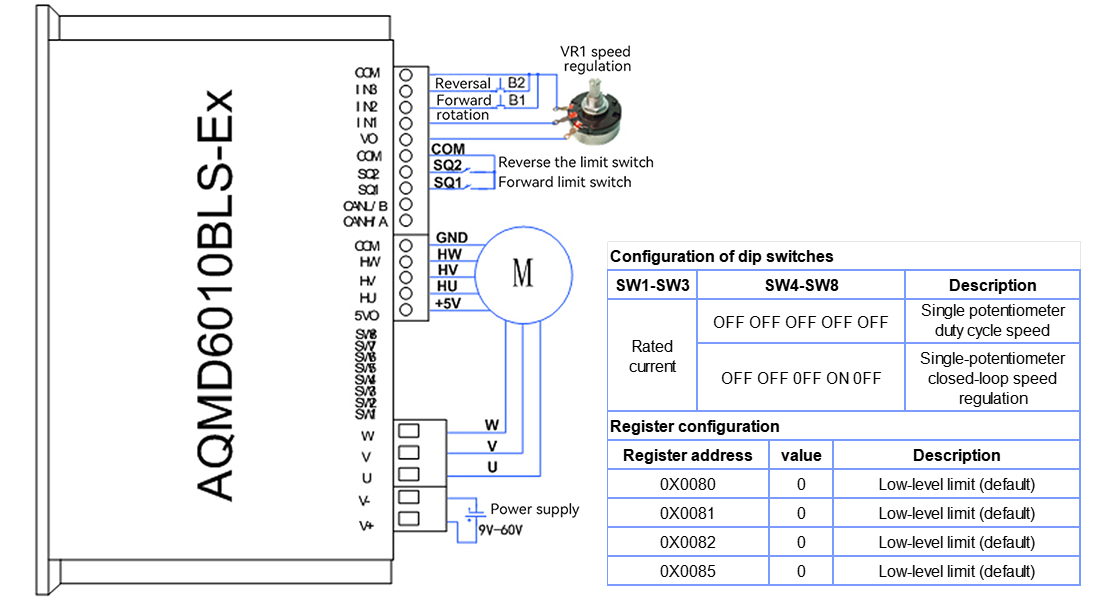
The working process of the point control mode using potentiometer speed regulation is as follows: Press B1, the motor rotates forward, and the speed regulation is carried out using the potentiometer. B1 bounces up and the motor stops. When the motor stops after the forward rotation limit, pressing B1 again is ineffective. Press B2 to reverse the motor. Use the potentiometer to adjust the speed. B2 bounces up and the motor stops. When the reverse limit is applied, the motor stops. Pressing B2 again is ineffective.
2. The connection method of duty cycle/closed-loop speed regulation of PLC analog signals
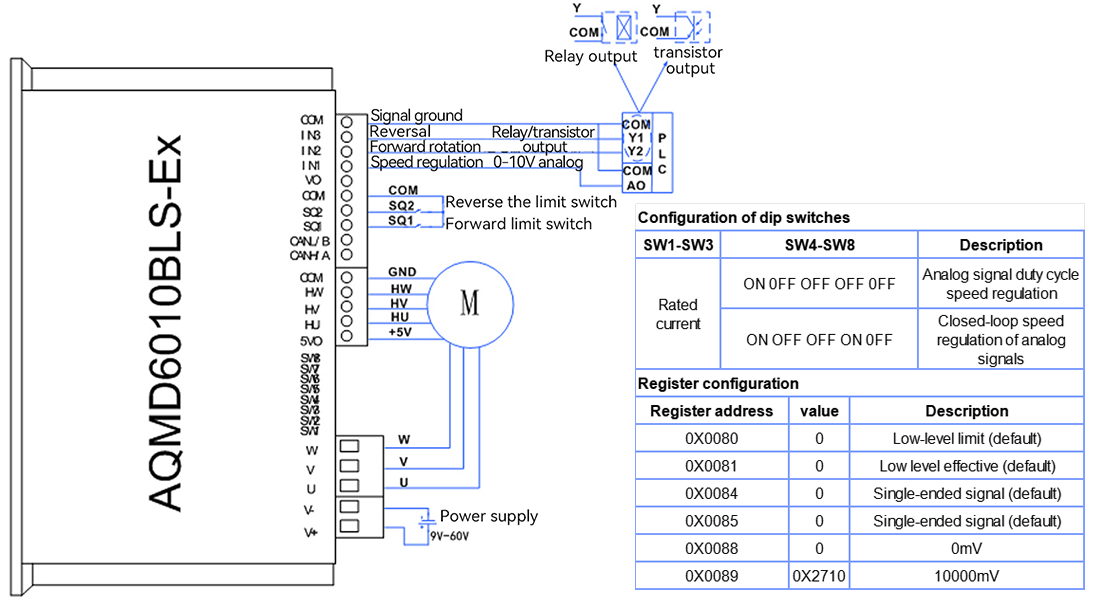
The working process of this connection method is as follows: IN1 is connected to the AO port of the PLC for speed regulation; IN2 and Y2 of PLC control the direction of the motor. IN3 is connected to Y1 of the PLC to control the emergency stop of the motor.
3. The connection method of duty cycle/closed-loop speed regulation of the PWM signal of the single-chip microcomputer
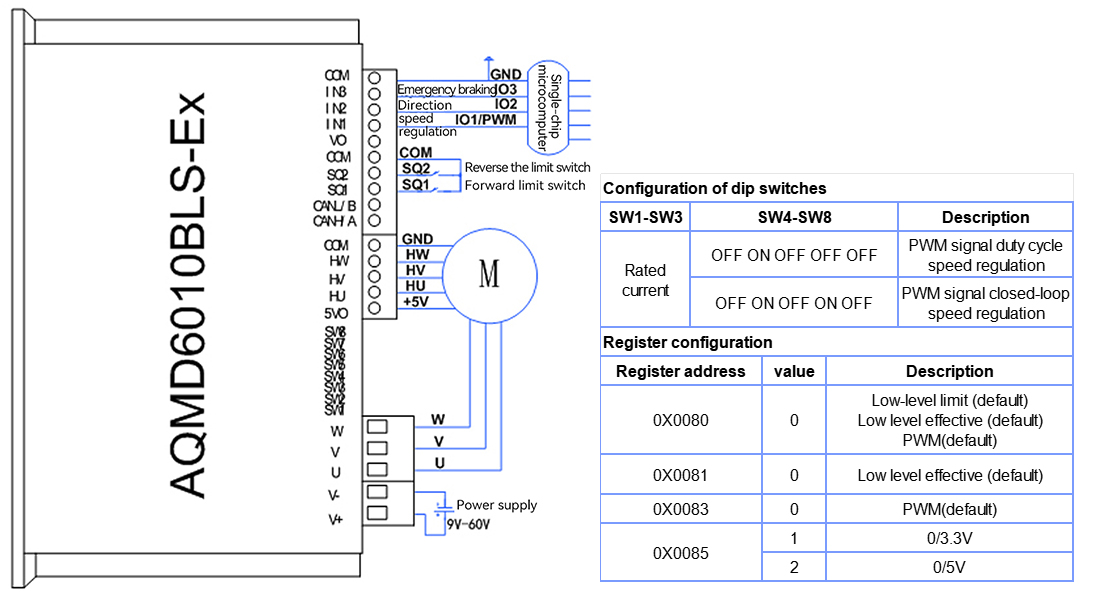
The working process of this connection method is as follows: The power supply of the single-chip microcomputer is grounded to the COM port of the drive module. Pin IN1 is connected to the PWM output of the single-chip microcomputer for speed regulation. IN2 and IN3 are connected to the two IOs of the single-chip microcomputer to control the forward and reverse rotation of the motor and emergency braking.
4. Connection method of pulse signal position control for single-chip microcomputer
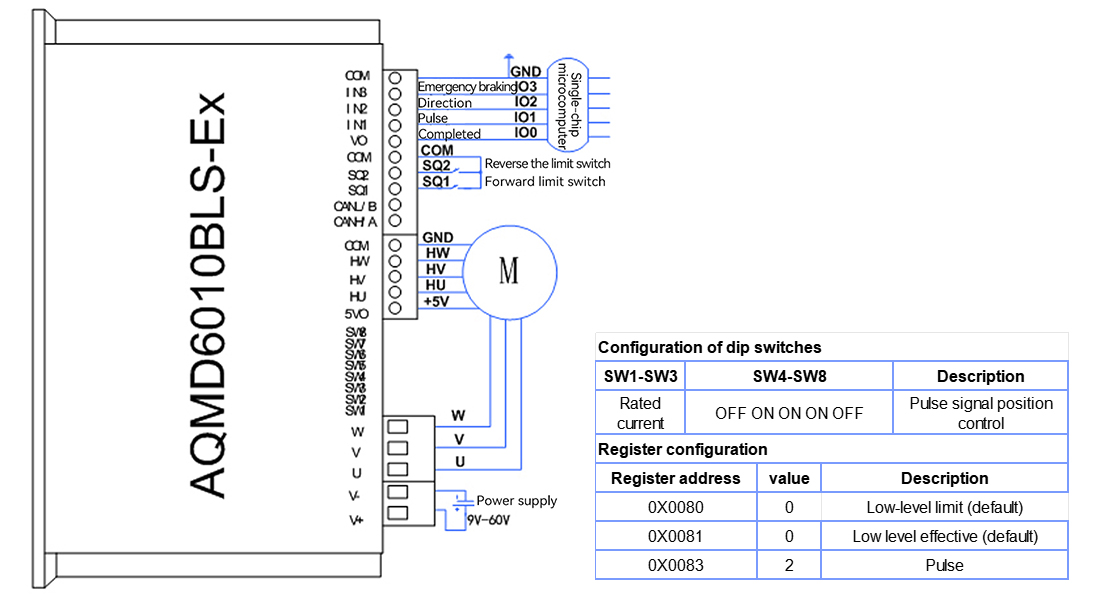
The working process of this connection method is as follows: The power supply of the single-chip microcomputer is grounded to the COM port of the drive module. IN1 is connected to IO1 of the single-chip microcomputer to determine the number of pulses, which is used for motor position control. VO is connected to IO0 of the single-chip microcomputer and is used to complete signal control. IN2 and IN3 are connected to the two IOs of the single-chip microcomputer to control the forward and reverse rotation of the motor and emergency braking.
5. Connection method for 485 multi-site control

The 485 communication lines of each driver are connected in parallel in the form of A-A and B-B and then linked to A 485 master station. The 485 master station operates each driver independently through the slave station address configured by the driver. The address configured for each drive should be unique and cannot be duplicated with that of other drives.
6. Connection method of CAN multi-node control
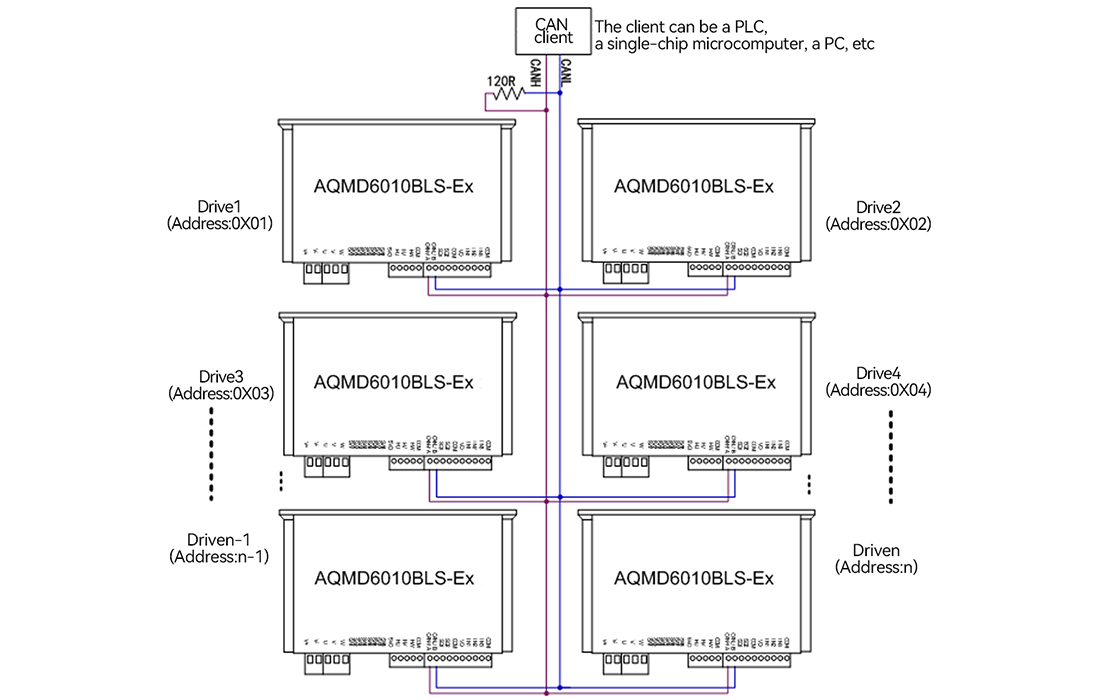
The CAN communication lines of each driver are connected in parallel in the form of CANH-CANH and CANL-CANL and then connected to the CAN client. At least one 120Ω resistor is connected in parallel on the CAN bus. The CAN client operates each driver independently through the node ID configured on the driver. The node ID configured for each drive should be unique and cannot be duplicated with that of other drives.
Sample program
Provide a PC sample program, which can be used for parameter configuration, motor debugging or secondary development.
Appendix: Selection reference
Selection Table for AQMD_BLS Series DC Inductive Brushless Motor Drivers
Model number | Functional characteristics | Maximum fit | Maximum current / | Energy braking | Control signal | Product size |
AQMD2403BLS-M | ● Minimal size | 12V18W | 6A/3A | 3A, do not brake frequently with high current | Single/dual potentiometer, 0-3.3V analog signal, logic level, switch, key, PWM, pulse, frequency, RS485 | 45x45x18mm bare board |
AQMD3605BLS-B2 | ● Overheat protection | 12V-30W | 10A/5A | 3A, do not brake frequently with high current | Single/dual potentiometer, 0-3.3V analog signal, logic level, switch, key, PWM, pulse/frequency, RS485 | 70x65x2lmm Raw board |
AQMD2408BLS-M | ● Compact size | 12V-45W | 16A/8A | 3A, non-battery power can not be high current frequent brake reversing | Single/dual potentiometer, 0-3.3V analog signal, logic level, switch, key, PWM, pulse/frequency, RS485 | 55x55x17mm bare board |
AQMD3608BLS | ● Rail mounting | 12V-50W | 10A/8A | 3A, do not brake frequently with high current | Single/dual potentiometer, 0-3.3/5/10V analog signal, logic level, switch, key, PWM, pulse/frequency, RS485 | 92x87x30mm bare plate |
AQMD6008BLS-T | ● Compact case | 12V-50W | 16A/8A | 3A | Single/dual potentiometer, 0-3.3V analog signal, logic level, switch, key, PWM, pulse/frequency, RS485 | 93x56x20.5mm |
AOMD6008BLS-TE/-I | Single/dual potentiometer, 0-3.3/5/10V analog signal, logic level, switch, key, PWM/ pulse/frequency, RS485/CAN | |||||
AOMMD6008BLS-TF/-I | ||||||
AQMD6010BLS-B2 | ● Overheat protection | 12V-60W | 20A/10A | 6A | Single/dual potentiometer, 0-3.3/5/10V analog signal, logic level, switch, key, PWM/ pulse/frequency, RS485 | 136x82x45mm |
AOMD6010BLS-E2 |
| 20A/10A | 6A | Single/dual potentiometer, 0-3.3/5/10V analog signal, logic level, switch, key, PWM/ pulse/frequency, RS485/CAN | 136x82x45mm | |
AOMD6010BLS-E2F | 8A | |||||
AQMD6020BLS-E2/E3 |
| 12V-100W | 35A/16A | 6A | Single/dual potentiometer, 0-3.3/5/10V analog signal, logic level, switch, key, PWM/ pulse/frequency, RS485/CAN | 136x82x45mm |
AOMD6020BLS-E2F | 8A | |||||
AQMD6030BLS-E2/E3 |
| 12V-180W | 40A/25A | 12A | Single/dual potentiometer, 0-3.3/5/10V analog signal, logic level, switch, key, PWM/ pulse/frequency, RS485/CAN | 136x82x45mm |
AQMD6030BLS-E2F | ||||||
AOMD6040BLS-E2 |
| 12V-240W | 50A/35A | 20A | Single/dual potentiometer, 0-3.3/5/10V analog signal, 0-3.3/5/24V logic level, switch, key, PWM, pulse, frequency, RS485/CAN communication | 178x108x68mm |
AQMD6040BLS-E2F | ||||||
AQMD12H10BLS-E2 | ● Overheat protection | 24V-200W | 25A/12A | 6A | Single/dual potentiometer, 0-3.3/5/10V analog signal, logic level, switch, key, PWM/ pulse/frequency, RS485/CAN | 136x82x45mm |
AOMD12H30BLS-E2 | ● Overheat protection | 24V-500W | 45A/30A | 12A | Single/dual potentiometer, 0-3.3/5/10V analog signal, logic level, switch, key, PWM/ pulse/frequency, RS485/CAN | 178x108x68m1 |
AQMD22A04BLS-E2 | ● Overheat protection | 72V-175W | 7A/3.5A | 3A | Single/dual potentiometer, 0-3.3/5/10V analog signal, logic level, switch, key, PWM/ pulse/frequency, RS485/CAN | 136x82x45mm |
Product protection
Multiple protections ensure safety and reliability

Overcurrent protection | Locked rotor protection | Voltage monitoring | Temperature monitoring | Communication isolation | Abnormal current protection |








